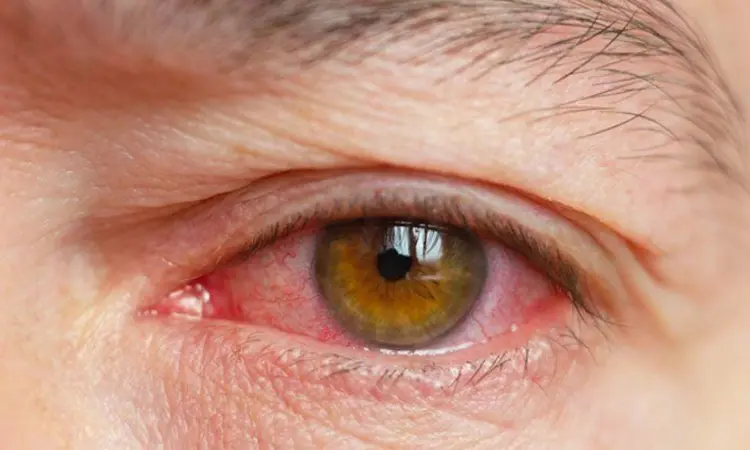- Home
- Medical news & Guidelines
- Anesthesiology
- Cardiology and CTVS
- Critical Care
- Dentistry
- Dermatology
- Diabetes and Endocrinology
- ENT
- Gastroenterology
- Medicine
- Nephrology
- Neurology
- Obstretics-Gynaecology
- Oncology
- Ophthalmology
- Orthopaedics
- Pediatrics-Neonatology
- Psychiatry
- Pulmonology
- Radiology
- Surgery
- Urology
- Laboratory Medicine
- Diet
- Nursing
- Paramedical
- Physiotherapy
- Health news
- Fact Check
- Bone Health Fact Check
- Brain Health Fact Check
- Cancer Related Fact Check
- Child Care Fact Check
- Dental and oral health fact check
- Diabetes and metabolic health fact check
- Diet and Nutrition Fact Check
- Eye and ENT Care Fact Check
- Fitness fact check
- Gut health fact check
- Heart health fact check
- Kidney health fact check
- Medical education fact check
- Men's health fact check
- Respiratory fact check
- Skin and hair care fact check
- Vaccine and Immunization fact check
- Women's health fact check
- AYUSH
- State News
- Andaman and Nicobar Islands
- Andhra Pradesh
- Arunachal Pradesh
- Assam
- Bihar
- Chandigarh
- Chattisgarh
- Dadra and Nagar Haveli
- Daman and Diu
- Delhi
- Goa
- Gujarat
- Haryana
- Himachal Pradesh
- Jammu & Kashmir
- Jharkhand
- Karnataka
- Kerala
- Ladakh
- Lakshadweep
- Madhya Pradesh
- Maharashtra
- Manipur
- Meghalaya
- Mizoram
- Nagaland
- Odisha
- Puducherry
- Punjab
- Rajasthan
- Sikkim
- Tamil Nadu
- Telangana
- Tripura
- Uttar Pradesh
- Uttrakhand
- West Bengal
- Medical Education
- Industry
Robot radiotherapy could improve treatments for eye disease, claims research

Researchers from King's, with doctors at King's College Hospital NHS Foundation Trust, have successfully used a new robot system to improve treatment for debilitating eye disease.
The custom-built robot was used to treat wet neovascular age-related macular degeneration (AMD), administering a one-off, minimally invasive dose of radiation, followed by patients’ routine treatment with injections into their eye.
In the landmark trial, published in The Lancet, it was found that patients then needed fewer injections to effectively control the disease, potentially saving around 1.8 million injections per year around the world.
Wet AMD is a debilitating eye disease, where abnormal new blood vessels grow into the macula, the light sensing-layer of cells inside the back of the eyeball. The vessels then start to leak blood and fluid, typically causing a rapid, permanent and severe loss of sight.
Globally, around 196 million people have AMD and the Royal College of Ophthalmologists estimates that the disease affects more than 700,000 people in the UK. The number of people with AMD is expected to increase 60% by 2035, due to the country’s ageing population.
Wet AMD is currently treated with regular injections into the eye. Initially, treatment substantially improves a patient’s vision. But, because the injections don’t cure the disease, fluid will eventually start to build up again in the macula, and patients will require long-term, repeated injections. Most people require an injection around every 1-3 months, and eye injections, costing between £500 and £800 per injection, have become one of the most common NHS procedures.
The new treatment can be targeted far better than existing methods, aiming three beams of highly focused radiation into the diseased eye. Scientists found that patients having robotic radiotherapy required fewer injections to control their disease compared to standard treatment.
The study found that the robotically controlled device saves the NHS £565 for each patient treated over the first two years, as it results in fewer injections.
The study lead and first author on the paper, Professor Timothy Jackson, King’s College London and Consultant Ophthalmic Surgeon at King’s College Hospital said: “Research has previously tried to find a better way to target radiotherapy to the macula, such as by repurposing devices used to treat brain tumours. But so far nothing has been sufficiently precise to target macular disease that may be less than 1 mm across.
“With this purpose-built robotic system, we can be incredibly precise, using overlapping beams of radiation to treat a very small lesion in the back of the eye.
“Patients generally accept that they need to have eye injections to help preserve their vision, but frequent hospital attendance and repeated eye injections isn’t something they enjoy. By better stabilising the disease and reducing its activity, the new treatment could reduce the number of injections people need by about a quarter. Hopefully, this discovery will reduce the burden of treatment that patients have to endure.”
Dr Helen Dakin, University Research Lecturer at the University of Oxford said: “We found that the savings from giving fewer injections are larger than the cost of robot-controlled radiotherapy. This new treatment can therefore save the NHS money that can be used to treat other patients, while controlling patients’ AMD just as well as standard care.”
Reference:
Prof Timothy L Jackson, Riti Desai, Hatem A Wafa, Prof Janet Peacock, Prof Tunde Peto, Stereotactic radiotherapy for neovascular age-related macular degeneration (STAR): a pivotal, randomised, double-masked, sham-controlled device trial, The Lancet, https://doi.org/10.1016/S0140-6736(24)00687-1.
Dr Kamal Kant Kohli-MBBS, DTCD- a chest specialist with more than 30 years of practice and a flair for writing clinical articles, Dr Kamal Kant Kohli joined Medical Dialogues as a Chief Editor of Medical News. Besides writing articles, as an editor, he proofreads and verifies all the medical content published on Medical Dialogues including those coming from journals, studies,medical conferences,guidelines etc. Email: drkohli@medicaldialogues.in. Contact no. 011-43720751


